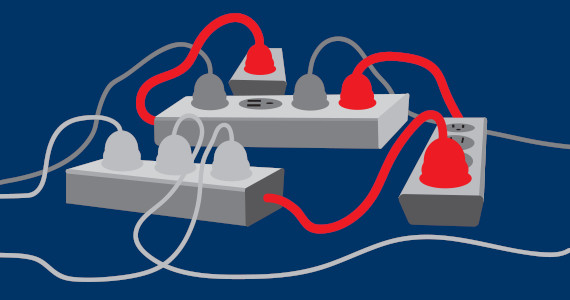
Power strips are essential for managing multiple devices in our homes and offices. They allow us to plug in various electronics from a single outlet, simplifying our lives. However, there’s a common practice known as daisy chaining that can turn this convenient tool into a dangerous hazard. Daisy chaining involves plugging one power strip into another, creating a chain of electrical distribution. While it might seem like a simple solution for extending reach or accommodating more devices, this practice significantly increases the risk of electrical accidents and fires.
This article will delve into the dangers of daisy chaining, explaining how it overloads circuits, creates fire hazards, and ultimately jeopardizes your safety. We’ll also explore safe practices for using power strips and ensure your devices operate safely and efficiently.
Daisy Chaining Explained
Daisy chaining occurs when you plug one power strip into another, effectively creating a chain of electrical distribution. Imagine plugging a power strip into an outlet, then taking that same power strip and plugging it into another power strip already plugged in. This continues until you reach the desired number of outlets or devices. While this might seem like a convenient way to extend your reach or accommodate more devices, it’s crucial to understand the inherent dangers associated with this practice.
The problem with daisy chaining lies in the cumulative effect on the electrical circuit. Each power strip adds resistance to the flow of electricity. When you chain multiple strips together, this resistance increases exponentially. As a result, the current flowing through the circuit becomes overloaded, exceeding the safe operating capacity of the wires and outlets involved.
Power Strip Overload
Overloading a power strip occurs when the total wattage drawn by all connected devices exceeds the strip’s maximum capacity. This can happen even without daisy chaining, but it becomes significantly more likely when you engage in this practice. Power strips have a specific amperage rating, indicating the maximum amount of current they can safely handle. When you exceed this limit, the wires within the strip become excessively hot, posing a fire hazard.
Daisy chaining exacerbates this issue by adding multiple power strips into the equation. Each additional strip contributes to the overall resistance and amp draw, pushing the circuit closer to its breaking point. Even if individual devices plugged into the chain are well below their rated wattage, the cumulative effect can still lead to an overload situation.
Fire Hazard Risks
The most significant danger associated with daisy chaining is the increased risk of fire. When a power strip or circuit becomes overloaded, the wires within it generate excessive heat. This heat can ignite nearby flammable materials, such as furniture, curtains, or even the plastic casing of the power strip itself.
Fire hazards are further amplified by the fact that daisy chained power strips often involve multiple outlets and devices in close proximity. A single fire ignited by an overloaded circuit could quickly spread throughout a room, causing extensive damage and posing a serious threat to life safety.
Electrical Accidents Prevention
Preventing electrical accidents starts with understanding the dangers of daisy chaining and adopting safe practices for using power strips.
Avoid Daisy Chaining:
The most crucial step is to avoid plugging one power strip into another. This practice creates an unnecessary burden on the electrical circuit and significantly increases the risk of fire and other hazards.
Use Surge Protectors:
Consider using surge protectors instead of regular power strips, especially for sensitive electronics like computers and televisions. Surge protectors offer additional protection against voltage spikes that can damage your devices.
Check Amperage Ratings:
Always check the amperage rating of both the power strip and the connected devices to ensure they are compatible. Never exceed the maximum amperage capacity of the power strip.
Safe Device Operation
To ensure safe device operation, follow these guidelines:
Unplug Unused Devices:
Unplug devices when not in use to reduce the overall load on the circuit and minimize energy consumption.
Distribute Load Evenly:
Distribute the load evenly across multiple outlets to avoid overloading any single strip or section of the circuit.
Inspect Power Strips Regularly:
Inspect power strips regularly for signs of damage, such as frayed cords, loose connections, or melted plastic. If you notice any issues, discontinue use immediately and replace the faulty strip.
Conclusion
Power strips are valuable tools for managing electrical devices, but it’s crucial to use them safely. Daisy chaining, while seemingly convenient, poses a significant risk of fire and electrical accidents. By understanding the dangers of this practice and adopting safe power strip usage habits, you can protect your home, devices, and most importantly, yourself from potential harm. Remember, when it comes to electricity, safety should always be the top priority.
